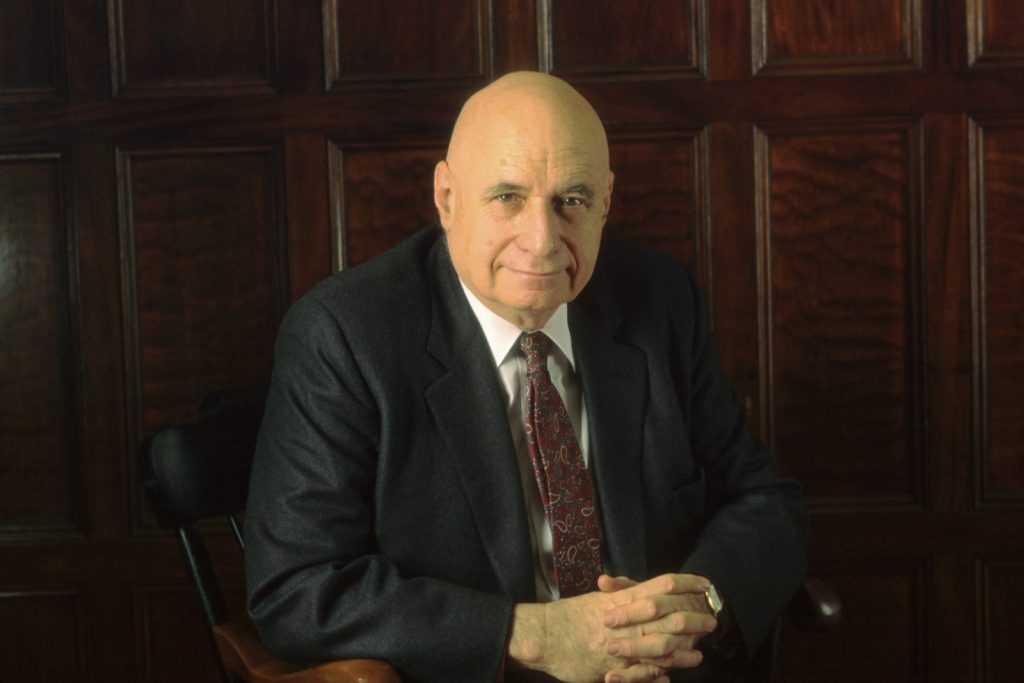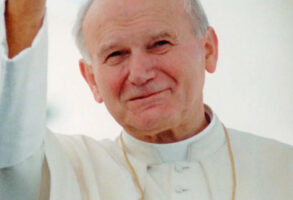
Published July 1, 2017
One by one, they leave the stage: Cardinal Avery Dulles, S.J.; Father Richard John Neuhaus; Michael Novak; now, on June 27, Peter Berger — men whose work I first read as an undergraduate, who later became friends and colleagues in a variety of enterprises. It’s a strange feeling, having been for decades the junior subaltern; now, increasingly, something of an elder. But what a preparation I was fortunate enough to have been given, first by these men’s books, then by our conversation and collaboration. Their generosity to young people eager to join their ranks is a gift I shall never forget, and one I hope I’ve learned to emulate.
I read a lot of Berger in college — Invitation to Sociology, The Social Construction of Reality, Movement and Revolution (co-authored with Neuhaus, then in his rabble-rouser-radical period), and A Rumor of Angels; the last, with its intriguing analysis of how everyday life sends out “signals of transcendence” that can open us to religious faith (or simply to a less-flattened, more capacious worldview) is a small work of genius on which I still rely in lectures today, some four decades later. I first met Berger during the founding days of the Institute on Religion and Democracy, which Peter helped launch along with the rest of the Catholic (or about-to-be Catholic) neo-con suspects and a handful of Evangelicals tired of their denominations’ drift into mindless (and, frankly, anti-Biblical) leftism, both theologically and politically. But it was not until the late spring of 1988 that I spent any significant time with Peter Berger: and a time it was.
Peter had a generous grant from a well-known conservative foundation and proposed to use the remainder of it to take Neuhaus, Novak, and me with him to Rome for a week, to engage Vatican officials in conversation about John Paul II’s 1987 social encyclical, Sollicitudo Rei Socialis (The Church’s Social Concern). As Berger often put it, “I am prepared to test the outer limits of the exotic in any culture in which I find myself, but I don’t like surprises before breakfast” — so we stayed atop Monte Mario at the five-star Cavalieri Hilton (now the Rome Cavalieri Waldorf Astoria). The headquarters for our expedition necessitated expensive cab rides to our Roman destinations but, pace Peter’s wishes, the Cavalieri guaranteed that there were no shockers pre–prima collazione.
I was a rank amateur as a Vaticanista in those days, and I suppose we were all a bit shocked by both the languid pace of the Roman Curia and the crotchetiness of even its mid-tier officials when even friendly questions were raised about their work. Later, I was to learn that John Paul II was as dissatisfied with the Curia’s work on what became Sollicitudo Rei Socialis as we were, but that’s a story to be saved for my memoir, Lessons in Hope, to be published in September, and in any event the experience was an invaluable one in introducing me to the ways of the Magic Kingdom on the Tiber.
Perhaps the most memorable Petrine moment of our week came as we were waiting in a badly lit and poorly decorated parlor outside the principal office of Cardinal Joseph Ratzinger, prefect of the Congregation for the Doctrine of the Faith — “formerly known as the Inquisition,” as reporters of a certain cast of mind never fail to remind us. The parlor included an unattractive painting of some historical scene or other — not, I hasten to add, the use of thumbscrews on heretics during the Counter-Reformation — and that nondescript picture initiated me into the world of Peter Berger’s robust sense of humor, which often combined deep historical knowledge with a whimsical view of the human condition. At any rate, we were all sitting, a bit awe-struck, in the great Ratzinger’s antechamber, when Peter observed out of nowhere that “this room is like a medieval dentist’s office. And speaking of dentists, look at that awful painting and remind yourself that, in any historical painting depicting a scene prior to the mid-19th century, 80 percent of the people in the picture are suffering severe tooth pain.” Delivered in Peter’s inimitably Viennese accent, a souvenir of the city of his birth, that droll observation had us all laughing, just before Ratzinger came out and greeted us.
Peter Berger had a remarkable gift for intellectual curiosity and an admirable willingness to admit that he was, on occasion, wrong. Thus the man who was once at the forefront of secularization theory (the claim that modernization inevitably involves radical and deep secularization) later came to admit that he’d had it wrong — and, indeed, that the secularization hypothesis had been empirically falsified everywhere in a world that was becoming more, not less, intensely religious, except for that outlier known as Western Europe. The American experience of hyper-modernization combined with intense religiosity had something to do with Peter’s change of mind on this point and led him to coin the immortal epigram, “The United States is a nation of Indians [the most intensely religious nation on earth] ruled by an elite of Swedes [the world’s most secular nation].”
In an intellectual journey that might once have surprised him, had anyone predicted it, Berger, with his respect for data, came to understand the importance of entrepreneurship, enterprise, and markets in giving the Third World the tools with which to lift itself up from misery and poverty. But he was never a romantic about capitalism, knew that economic development involved disruptive cultural costs, and was always sensitive to what Reinhold Niebuhr would have called the inevitable tragedies of history in an imperfect world. He was fascinated by Asia, hoped that Malaysia and Indonesia might provide models of a modernizing Islam liberated from the pathologies of the Arab Middle East, and maintained an extraordinarily wide range of contacts with scholars, businesspeople, and activists all over the Third World. Their common bond was a willingness to think outside the box about political and economic development while always keeping in mind the cultural preconditions necessary to make free politics and free economics work.
My last two extended experiences with Peter — in Berlin in December 2007 and in Boston in April 2015 — gave me an even deeper appreciation of his insatiable curiosity and his commitment to intellectual ecumenism. In Berlin, he gathered a divergent crew to try to beat some sense into German social democrats about religion and society (meaning, in the main, to try to deprogram them from their conviction that religiously informed public moral argument was always bad news in a democracy). I don’t think we made much headway, but it wasn’t because of Peter’s indefatigable good humor, intellectual energy, and language skills. In Boston, a similarly across-the-ideological-board cast of characters spent three sharp-edged days under Peter’s direction, exploring the ways in which various religious communities and cultures coped (or didn’t cope) with late modernity and post-modernity. Like his longtime friend Neuhaus, Berger was a masterful conference chairman, always asking the probing question that got everyone on their toes and thinking out of their accustomed intellectual comfort zones. That he pulled off the Boston conference while confined to a wheelchair demonstrated that his physical courage matched his intellectual boldness.
Peter’s marriage to fellow sociologist Brigitte Kellner, herself a distinguished scholar (and survivor of a Nazi concentration camp), was one of the greatest I’ve ever witnessed. And in the two years since Brigitte’s death in 2015, Peter’s first response to my telephonic inquiries about how he was doing was always the same: He spoke of how much he missed his wife. But then we moved on to the other staple of our conversation, the exchange of new jokes we had heard. I have known some great storytellers, but I have rarely met anyone who reveled in jokes as much as Peter did — especially jokes that ethnic or national groups told about themselves, thereby revealing (wittingly or not) some of their deepest characteristics.
He had a deeply Lutheran view of the world and of life; there was no “Brother Sun, Sister Moon” in Peter Berger. But his fondness for jokes and his delight in sharing them suggested that, at bottom, he knew that it was all a divine comedy, whatever the chiaroscuro shadings.
— George Weigel is Distinguished Senior Fellow of the Ethics and Public Policy Center, where he holds the William E. Simon Chair in Catholic Studies.











